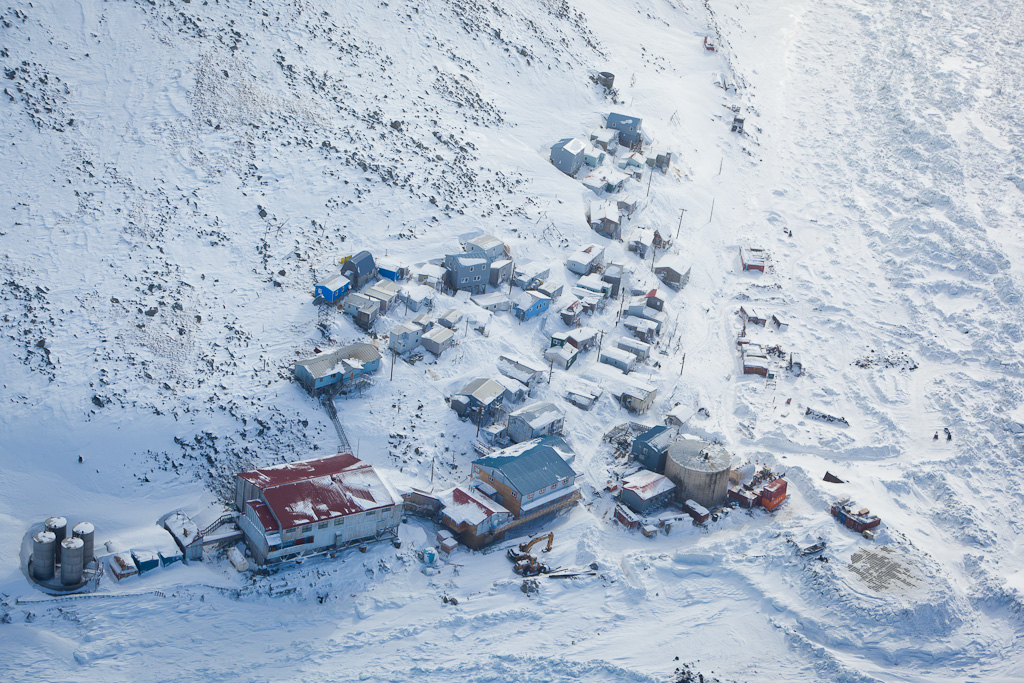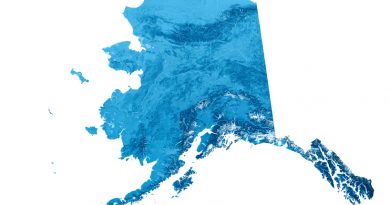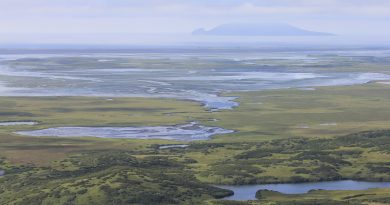Can remote Little Diomede, Alaska exploit the future?
 LITTLE DIOMEDE, Alaska – Build it and they will come. Don’t and they will pass by.
LITTLE DIOMEDE, Alaska – Build it and they will come. Don’t and they will pass by.
This is the trendy, yet sincere, Arctic call-to-action about ports and ice breakers among big thinkers who plan for the future and fear what will happen if others don’t.
All of the societal issues that get policy makers worked up – economies and commerce, health, transportation, education, environment, national defense – are precariously encased in the vision of an ice-free Arctic bustling with industry and tourism.
In the middle of all of this sits Little Diomede, a village of about 100 people where Ingalikmiut Eskimos still live off the land, hunting polar bears and other marine mammals for food.
Two and a half miles to the west is its foreign sister outpost, Russia’s Big Diomede. To its east is mainland Alaska, where the conveniences of thriving economies – hospitals, bigger grocery stores, retail operations and more jobs – await. To its north and south are the Chukchi and Bering Seas, respectively.
Little Diomede borders the Bering Strait where the narrow channel pours into the Arctic. To the south, the strait is bookended by St. Lawrence Island. This thin band separate two countries and is a thoroughfare from the Pacific Ocean to the top of the world.
It’s a place that can feel out-of-sync with the western world. Rooted in the past, it exists intwertined – however loosely – with modern outside culture and conveniences. Some residents will live out their lives here. Others will leave.
With climate-change scientists all but assuring us we will witness an ice-free arctic in our lifetime, governments and business interests are abuzz with what it means to life in the far north. But there may be a disconnect between benefits perceived for a single community versus those that are good for a state or a nation. One size rarely fits all.
New horizons
Ice-breaking tankers from Russia are already shuttling petroleum to markets on the other side of the world by cutting through the arctic to save hundreds of miles in transit. Now, Alaska and the United States are thinking about how we catch up, how we do it better, how we make sure anything done is done safely — and ensuring that Alaskans can get help if things go awry.
Oil companies are already looking to search beneath additional arctic waters for oil and gas, and Shell Oil is poised to drill this year. What will happen if more companies do the same? If more cruise ships pass through? If cargo freighters decide cutting through the Northwest Passage saves big money?
Will these ships have safe places to anchor if they need to wait out bad weather or need repairs? Will Alaska have ice-breakers on hand to assist ships through our cold-hearted and often-fickle seas?
Faced with the realities of a changing arctic, old ideas are surfacing again, including one to build a tunnel connecting Alaska to Russia via the Bering Strait. Others are calling for a way to monitor sea traffic.
Embracing these prospects, some believe, will improve life in Alaska communities that for years have struggled to find stable economic anchors. Ports could lead to job creation, helping local communities capture a piece of the wealth big ships and new development create.
Maybe. Maybe not.
Big barriers
Over the years, Little Diomede has been about as isolated as isolated can get in Alaska.
By virtue of its location, Little Diomede has always been a crossroads. In March, locals were thankful for a new school on the island — but unhappy with the school principal. Such disputes are common in Alaska’s small communities, where locals can be leery of outsiders and outsiders may not fit in.
On a recent visit, ivory carvers and skin sewers on the island didn’t have as much to sell as normal. A few locals thought this was because some hunters and artists had been overcome by drug addictions, stealing away their will to hunt the animals from which material for carvers and sewers is harvested. In a small place, having just a few people in a downward spiral can disrupt the entire community’s balance. The school principal also thought drug use had sidelined some older students within the last year.
Good-paying jobs in Little Diomede, ones that come with decent pay, retirement and health benefits, are sparse. Cruise ships that once delivered passengers to the island for a look around, to buy crafts, to watch dancers or go birdwatching no longer stop.
With state and national policy-makers increasingly attuned to the arctic, what’s Little Diomede’s place in their visions?
“I don’t see even 10 years from now it getting much better,” said village council president Orville Ahkinga, who grew up in house made of sod and rocks, before fabricated housing came to the island. “It’s real difficult trying to live back in the past. Living back then was a very peaceful life. Everyone worked together.”
These days there are plenty of part-time jobs on the island. People are needed to maintain the trails that lace through the community, man shifts at the store, pick up trash and keep things clean. But too few people are stepping up to do the work, Ahkinga said.
He blames the apathy on a relatively new phenomenon to Little Diomede – the use of synthetic marijuana. It’s so bad, the village council has set up a community meeting to talk about how to keep drugs off the island.
“If it continues, this poor little village will die off because of that stuff. It’s addictive,” he said.
A lack of law enforcement doesn’t help. There are no state troopers, no village safety officers stationed on the island.
‘We may all be gone’
Given a choice, Ahkinga said it would difficult to decide whether to raise children on or off the island. Isolation makes it tough to bring the modern conveniences to Little Diomede. Yet many families fear that fitting in somewhere else could be even more difficult.
Communities tend to be protective of their lands. Getting a family or clan to abandon its home turf, to live disconnected from its source of identity while expecting new hosts to extend warm welcomes won’t come easily, he said.
A developed arctic could help. But it may also hurt.
If ports provide safe harbors for boats, locals might be able to make a living as fishermen.
“That would really get the economy going for rural villages,” Ahkinga said.
But he worries too much large ship traffic in the spring and fall could scare off the seals, walrus, whales and polar bear he and others live on – and that tether today’s residents to generations past.
Connecting Little Diomede to the future in meaningful ways will be challenging, Ahkinga said. A runway for aircraft landings, better healthcare, new buildings. All are needed, and all will be difficult to obtain, he said, pointing out that the island has little room to expand.
Little Diomede has a front-row seat to changes happening at the top of the world, but in many ways is lost within the blind spot big ideas and big changes can create.
He would like to see islanders maintain their village and thrive.
“Diomede should stay Diomede. I don’t think anyone should move,” he said, at the same time acknowledging he believes that young people should be free to choose to pursue their dreams wherever they choose. “I can’t predict the future. We may all be gone.”
Contact Jill Burke at jill(at)alaskadispatch.com
For more stories from Alaska Dispatch, click here.



